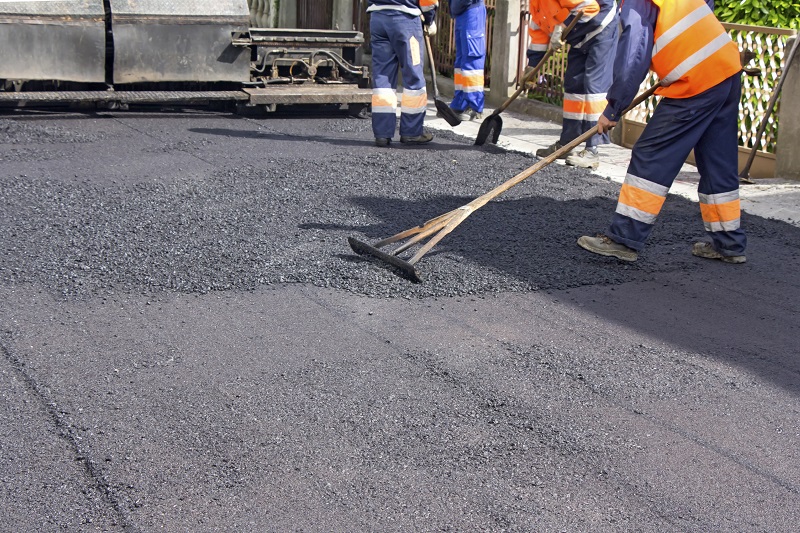Hot Mix Asphalt Paving: Elevating Commercial Parking Lot Specifications
Hot Mix Asphalt Paving: Elevating Commercial Parking Lot Specifications
Blog Article
Unlocking the Secrets of Warm Mix Asphalt Modern Technology
Exploring the depths of warm mix asphalt innovation discovers a world where precise solutions and careful processes merge to form our roadways and infrastructure. The blend of fillers, accumulations, and binders isn't simply a building and construction task but a critical orchestration of longevity and efficiency.
Significance of Hot Mix Asphalt
Hot Mix Asphalt plays a critical function in contemporary framework development due to its durability and cost-effectiveness. As the most frequently utilized leading product for roadways, freeways, and parking lots, Hot Mix Asphalt provides a range of benefits that contribute to its significance in building projects.
The resilience of Warm Mix Asphalt stems from its composition, which consists of aggregates, binder, and filler materials that are carefully picked and blended to meet particular efficiency demands. This specific combination results in a flexible and solid sidewalk that can sustain regular use without considerable deterioration. Hot Mix Asphalt is 100% recyclable, further enhancing its sustainability and ecological benefits. In general, the value of Warm Mix Asphalt in facilities development can not be downplayed, as it continues to be a cornerstone of contemporary construction practices.
Parts of Asphalt Mixes
The structure of asphalt mixes consists of thoroughly picked accumulations, binder, and filler materials that are important for accomplishing specific efficiency demands. Accumulations are the key part of asphalt blends, giving toughness and stability. The binder, typically bitumen or asphalt concrete, holds the accumulations with each other and supplies versatility and sturdiness to the mix.
The combination and proportion of these parts play a substantial function in identifying the top quality and performance of the asphalt mix. Engineers carefully make the mix to satisfy particular requirements, thinking about variables like web traffic volume, environment problems, and pavement life expectancy. Correct choice and harmonizing of aggregates, binder, and fillers are important for producing long lasting, durable asphalt pavements.
Mixing and Production Techniques

Once the accumulations are selected, the binder, typically asphalt cement, is added to bind the materials with each other. The binder's quality and amount dramatically impact the mix's toughness, resistance, and versatility to environmental aspects. In addition, fillers like hydrated lime or Rose city cement may be integrated to improve particular features of the asphalt mix, such as its workability or moisture resistance.
Throughout production, the accumulations and binder are heated up, usually in between 250-325 ° F(121-163 ° C ), to assist in mixing and make certain correct finishing of the accumulations. The blending procedure must be thorough to achieve an uniform mixture that advertises the preferred performance qualities of the asphalt. Different strategies, such as set mixing or drum mixing, are utilized to attain constant and high-quality asphalt mixes for building projects.
Aspects Affecting Asphalt Performance
Factors influencing asphalt performance include an array of variables that impact the toughness, durability, and general top quality of asphalt pavements. One crucial factor is the high quality of materials utilized in the asphalt mix.
:max_bytes(150000):strip_icc()/asphalt-worker-134249388-58cdf96f5f9b581d723f2f33.jpg)
Ecological conditions likewise affect asphalt performance. Temperature variations, wetness seepage, and web traffic loads can all impact the structural integrity of the pavement. Style considerations, such as sidewalk thickness and drain, are necessary in making certain the long-lasting performance of the asphalt sidewalk. By thoroughly thinking about these elements, engineers and contractors can enhance asphalt performance and improve the service life of sidewalks.
Sustainable Practices in Asphalt Innovation

In addition, the development of warm-mix asphalt (WMA) innovations has actually gotten traction in recent times. WMA enables the manufacturing and placement of asphalt mixes at reduced temperature levels contrasted to standard hot-mix asphalt, leading to minimized power intake and greenhouse gas exhausts. The usage of porous asphalt mixes can help alleviate stormwater overflow problems by enabling water to penetrate via the sidewalk and right into the ground, advertising all-natural water filtering and recharge processes. By executing these lasting methods, the asphalt sector can add to building a more eco-friendly and durable framework network.
Final Thought
In conclusion, hot mix asphalt technology plays a crucial role in modern facilities advancement due to its sturdiness and cost-effectiveness. By meticulously stabilizing elements, employing see page proper blending strategies, and thinking about numerous factors, engineers can produce top quality asphalt blends that withstand hefty website traffic lots and severe weather. Embracing sustainable techniques, such as using recycled materials and warm-mix technologies, further boosts the environmental friendliness of asphalt innovation.
Blending and manufacturing techniques in warm mix asphalt innovation include the exact mix and processing of accumulations, binder, and fillers to produce a durable and high-performance asphalt mix.Elements influencing asphalt efficiency incorporate a range of variables that impact the durability, longevity, and overall high quality of asphalt pavements. Sustainable techniques in asphalt technology incorporate different initiatives aimed at reducing the environmental effect of asphalt manufacturing and paving processes. By integrating reclaimed asphalt sidewalk (RAP) and recycled asphalt shingles (RAS) right into new asphalt mixes, the industry can considerably lower the consumption of raw materials and energy, while additionally decreasing landfill waste.
WMA allows for the production and placement moved here of asphalt blends at reduced temperatures contrasted to typical hot-mix asphalt, resulting in reduced power intake and greenhouse gas discharges.
Report this page